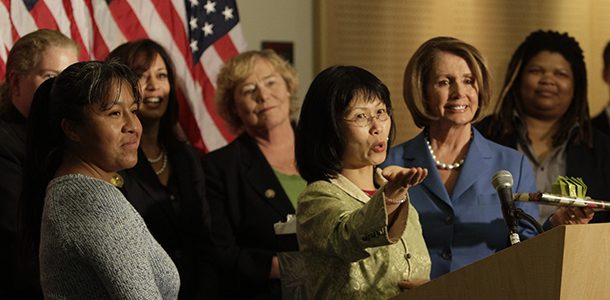
(Photo Credit: Mona T. Brooks/Nancy Pelosi/Wikimedia Commons)
It is hard to believe that the first state in the country’s history to have two women serving as U.S. Senators at the same time might have a problem attracting women to run for public office, but that’s the situation in California.
Diane Feinstein and Barbara Boxer were the first women ever to be U.S. Senators from the same state at the same time. New Hampshire and Washington now can also make that claim.
A recent study of local government in California showed there’s been an increase in the number of women elected to city councils. Yet, other data points are still discouraging.
“Only two of the 12 largest cities have women as mayors,” said Rachel Michelin, executive director and CEO of California Women Lead, a bipartisan group working to empower and elect more women in California. “And California has never had a woman governor.”
In partnership with League of California Cities Women’s Caucus, the group released an update to their report on the status of women in city government, which showed a net gain of 21 more women on city councils compared to the previous report.
But, there’s also been a decline in women serving in the state legislature. Michelin also pointed out her regret over Toni Atkins (D-San Diego) stepping down as Assembly Speaker and Kristen Olsen (R-Modesto) leaving her minority leadership role in the Assembly. Both are being replaced by men.
So there is still work to do.
California Women Lead is working to identify and recruit women across California to government, either by appointment or as candidates.
“Governor Brown has been a champion for women in public service,” said Michelin, emphasizing that 50 percent of his appointees to boards and commissions have been women.
But she points out it’s still a numbers game. In 2012, in the wake of redistricting, there were 15 open legislative seats that had political contests with no women running.
“We’re already looking at 2022 after the next redistricting when our goal is to have a serious women candidate running in every single legislative district,” said Michelin.
In the meantime, California Women is holding training and workshops across California. A recent event in Temecula attracted more than 100 women. A similar training is scheduled for Bakersfield in October.
“Women bring a different voice to policy making,” Michelin pointed out. She also believes that the recently passed electoral reforms, particularly California’s top-two open primary, represent a huge advantage for women.
“With an emphasis on more bipartisan collaboration, today’s environment favors the qualities that women bring to public service,” Michelin said.
However, she added, one negative is the cost of campaigning and how the money is raised. She pointed to the recent State Senate special election in the San Francisco Bay Area, which generated $10 million in special interest spending.
“Many women are saying, ‘Why bother?'”
In the meantime, the early stirrings of the 2016 campaign have already attracted strong women.
The U.S. Senate race has two women already in the running, Attorney General Kamala Harris and Congresswoman Loretta Sanchez.
“They have distinct styles from each other,” Michelin said. “It promises to be an interesting race.”
And of course, there are the presidential primaries with a strong woman candidate with a chance to win the nomination of both major parties.
“Carly Fiorina’s recent performance in the Republican debate indicates she’ll be in the race for the long haul,” Michelin said, also pointing out that Hillary Clinton is still the front-runner for the Democratic nod.
For California Women Lead, the work continues to identify, recruit and retain women interested in public service.

